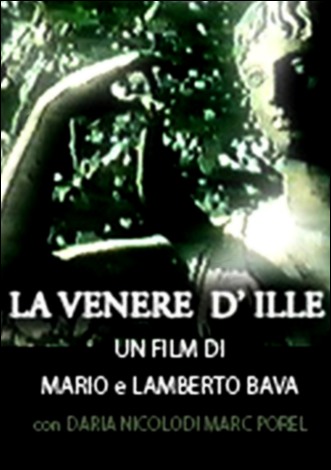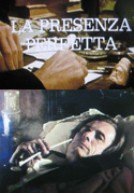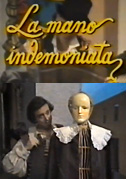 The Italian TV miniseries I GIOCHI DEL DIAVOLO: STORIE FANTASTICHE DELL’OTTOCENTO (THE DEVIL’S GAMES: FANTASTIC STORIES OF THE NINETEENTH CENTURY) consists of six mini-films by varied directors. Each episode runs a little over an hour, and each is based on a 19th Century horror story selected by the renowned Italian fantasist Italo Calvino (selections that were incorporated into Calvino’s 1983 anthology FANTASTIC TALES: VISIONARY AND EVERYDAY).
The Italian TV miniseries I GIOCHI DEL DIAVOLO: STORIE FANTASTICHE DELL’OTTOCENTO (THE DEVIL’S GAMES: FANTASTIC STORIES OF THE NINETEENTH CENTURY) consists of six mini-films by varied directors. Each episode runs a little over an hour, and each is based on a 19th Century horror story selected by the renowned Italian fantasist Italo Calvino (selections that were incorporated into Calvino’s 1983 anthology FANTASTIC TALES: VISIONARY AND EVERYDAY).
Broadcast in May through June of 1981, I GIOCHI DEL DIAVOLO can be viewed as a rival of sorts to the French program HISTOIRES EXTRAORDINAIRES, which likewise consisted of six horror story adaptations (all by Edward Allan Poe) that premiered in February-March of ‘81. As with that series, I GIOCHO DEL DIAVOLO’S episodes are quite varied in style and quality, yet the series overall, like HISTOIRES EXTRAORDINAIRES, provides a good representation of the power of European television in the late 20th Century, which accorded a reverence to fantastic and horrific literature that European (and American) features of the 1980s didn’t.
“L’Uomo Della Sabbia” started things out. Its source was E.T.A. Hoffmann’s classic 1816 tale “Der Sandmann” (which was also adapted to the screen by Eckhart Schmidt in 1993) and the director the famed avant-gardist Giulio Questi, of the classic mind-benders DJANGO KILL! and DEATH LAID AN EGG. “L’Uomo Della Sabbia” forms a twosome of sorts with Questi’s “Vampirismus” (1982), another made-for-Italian television adaptation of an E.T.A. Hoffman tale. Neither film, alas, is among Questi’s best work.
The visual sense Questi demonstrated in his earlier features is very much evident in the strikingly shadowy lighting and masterful handheld camerawork of “L’Uomo Della Sabbia.” As in the story, Questi’s film focuses on Nataniele, a man haunted by a figure from his childhood who may have murdered his father—and who, it appears, is still extant in the guise of a local instrument trader.
Nataniele also becomes besotted with Olimpia, a creepy automaton whose presence, incarnated by actress Francesca Muzio, provides an ideal  opportunity for Questi exercise his gift for bizarre imagery. This is particularly evident in the film’s climax, involving a disembodied head and eyes. Such demented energy, alas, is in scant evidence in the rest of the film, which despite Questi’s visual brilliance is somewhat lacking in inspiration.
opportunity for Questi exercise his gift for bizarre imagery. This is particularly evident in the film’s climax, involving a disembodied head and eyes. Such demented energy, alas, is in scant evidence in the rest of the film, which despite Questi’s visual brilliance is somewhat lacking in inspiration.
“La Venere D’Ille” is the best known of I GIOCHI DEL DIAVOLO’S episodes due to the fact that it was jointly helmed by the legendary Mario Bava and his son Lamberto, it being the final directorial credit of the former and the first for the latter. The source tale was “Venus d’Ille,” Prosper Merimee’s 1835 story about a living statue doing scary things, which has inspired several films over the years, including a 1922 Austrian silent and a 1969 Polish TV adaptation by director Janusz Majewski.
It involves a most troublesome bronze statue of a beautiful woman that has an unfortunate habit of moving by itself and injuring people. On the day of his wedding the wealthy young Alfonso (Fausto Di Bella) impetuously places the ring of his bride Clara (Daria Nicolodi) on the hand of the statue, causing it to take on the guise of Clara.
This pic contains a fair amount of Mario Bava’s trademarked visual bravura, but, as with the previous episode, lacks the energy of his better known features. In common with the Merimee text, the proceedings are kept resolutely low key and non-aggressive; the expected moving statue effects are nowhere to be found, with a climactic stalking sequence conveyed entirely through a lengthy POV shot and a subsequent murder occurring off-screen.
 Henry James’ 1891 story “Sir Edmund Orme” provided the source material for “La Presenza Perfetta.” The tale, set amid upper-crust Britons and related in James’ impeccably refined manner (which describes a sky as “even more respectable than lovely” and an ocean as “decorous”), wouldn’t appear to lend itself particularly well to the TV drama format. Director Piero Nelli, however, makes a conditional success of the job, turning out a handsomely mounted, atmospheric little film that forsakes the staginess of so many of I GIOCHI DEL DIAVOLO’s other segments in favor of a full-bodied 19th century setting.
Henry James’ 1891 story “Sir Edmund Orme” provided the source material for “La Presenza Perfetta.” The tale, set amid upper-crust Britons and related in James’ impeccably refined manner (which describes a sky as “even more respectable than lovely” and an ocean as “decorous”), wouldn’t appear to lend itself particularly well to the TV drama format. Director Piero Nelli, however, makes a conditional success of the job, turning out a handsomely mounted, atmospheric little film that forsakes the staginess of so many of I GIOCHI DEL DIAVOLO’s other segments in favor of a full-bodied 19th century setting.
It stars the Italian sleaze movie veteran William Berger as Henry, who falls in love with the fetching young Charlotte (Emanuela Barattolo), which gives him the ability to see the long-dead Sir Edward Orme (Franco Ressel). Charlotte’s widowed mother Annie (Rada Rassimov), it seems, was set to marry Orme but abruptly called off the engagement, leading him to commit suicide. Since the death of Annie’s husband Orme’s spirit has attached itself to her daughter, and can only be freed by Annie’s death.
I’m not sure I agree with the Theremin-like sound effects that accompany Orme’s every appearance, but for the most part “La Presenza Perfetta” is a surprisingly effective piece of work, and the most satisfying of I GIOCHI DEL DIAVOLO’S segments.
“La Mano Indemoniata” was adapted from “La Main Enchantee” by Gerard de Nerval, a 1932 tale that also provided the basis for Maurice Tourneur’s LA MAIN DU DIABLE (1942). That film is a classic, while this one, alas, is most definitely not.
 Director Marcello Aliprandi plays somewhat fast and loose with the Nerval story, which is quintessentially French in all respects, down to the Parisian locations specified throughout the story. Those locations are replaced here with patently stage-bound sets that flaunt their artificiality, making this essentially a work of filmed theater (in the manner of the classic 1972 French miniseries LES ROIS MAUDITS).
Director Marcello Aliprandi plays somewhat fast and loose with the Nerval story, which is quintessentially French in all respects, down to the Parisian locations specified throughout the story. Those locations are replaced here with patently stage-bound sets that flaunt their artificiality, making this essentially a work of filmed theater (in the manner of the classic 1972 French miniseries LES ROIS MAUDITS).
Its protagonist is Eustachio (Cochi Ponzoni), a perpetual screw-up who to sort out his problems heads for the creepy realm of a supernaturally endowed gypsy—and does so, appropriately enough, on a dark and stormy night. The gypsy, who lives with a cat that periodically transforms into a black suit wearing woman, sprinkles a potion on Eustachio’s right hand that causes it to act on its own accord. The following day a rival of Eustachio is killed by the errant hand, which proves quite adroit with deadly swordplay. It also smacks around several folks and continues its reign of terror even after being severed from its owner’s arm, in a Grand Guignol finale that provides “La Mano Indemoniata’s” only real point of interest.
“Il Diavolo Nella Bottiglia” was adapted from Robert Louis Stevenson’s 1893 tale “The Bottle Imp.”
Director Tomaso Sherman helms in a highly operatic manner that as with the previous episode utilizes patently stage-bound scenery and pays particular attention to the positioning of the actors, who all deliver highly stylized performances. It’s a more interesting film overall than “La Mano Indemoniata,” with a pleasing quasi-comedic tone and a definite baroque artistry in its set design. There’s also a pointed political angle that wasn’t present in the original story—more on that in a bit.
Here an impoverished Hawaiian sailor named Keawe (Stefano Sabelli, who for some reason spends most of the pic with his shirt off) encounters an eccentric American flag hat wearing old man (Ezio Marano) peddling a bottle that houses a Hell-spawned imp that can allegedly make one’s every wish come true. The catch is that the bottle has to be sold before its owner’s death or that person will be dragged to Hell by the Imp. How then to get rid of the bottle? It has to be sold for less than the current owner paid for it.
Keawe, figuring he has nothing to lose, buys the bottle from the old man. The bottle imp brings riches, and also the hand of a virtuous woman, but Keawe comes to regret the purchase, and decides to sell the thing—and that’s when the fun really begins!
Interesting film, but the homo-erotic angle (the leading actor rarely ever appears fully clothed) is a distraction, as is the American flag imagery, which has the effect of transforming Robert Louis Stevenson’s universally accessible parable of longing and corruption into a simple-minded political screed.
The sixth and final episode is “Il Sogno Dell’Altro,” an adaptation of H.G. Wells’ “The Story of the Late Mr. Elvesham” (1896). In it the naive Edward (Stefano Madia) agrees to become the beneficiary of the will of the ailing Albert Elvesham (Jose Quaglio). What Edward doesn’t realize is that he’ll be inheriting a lot more than money, as Elvesham is a body snatcher of sorts, and Edward is set to become his latest vessel.
The pic is marked by a disarmingly somber, poignant atmosphere, and a great deal of mirror imagery—which makes sense, given that the protagonist’s horror at his changing appearance is an integral part of the narrative. There’s also a striking intersecting-staircase setting that grows increasingly surreal, with the background done up as a blue sky that at one point transforms into a massive rose.
The Wells text, which is highly introspective in nature, is not particularly well suited to the screen, as is evident in the painfully uneventful narrative and director Giovanna Gagliardo’s overuse of voice-over narration—although there is a final dramatic flourish that intriguingly ties this account in with Oscar Wilde’s PICTURE OF DORIAN GREY.
I’ve heard this series was set to continue beyond “Il Sogno Dell’Altro,” but for whatever reason (budgetary overruns? low ratings?) it ended after just six episodes, a somewhat interesting bunch of mini-films whose cumulative effect is semi-successful at best. Indeed, it seems I GIOCHI DEL DIAVOLO was still finding its footing when it was cancelled, leaving us with a program that’s more interesting for what it could have been rather than what it is.
